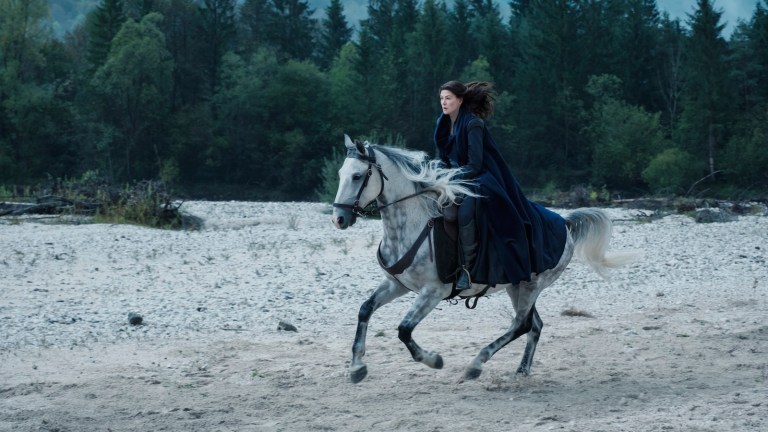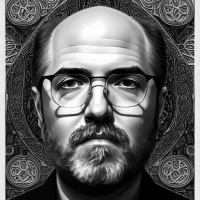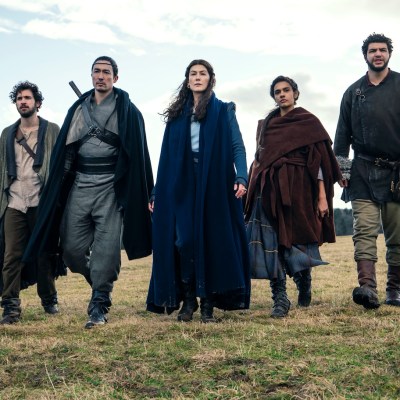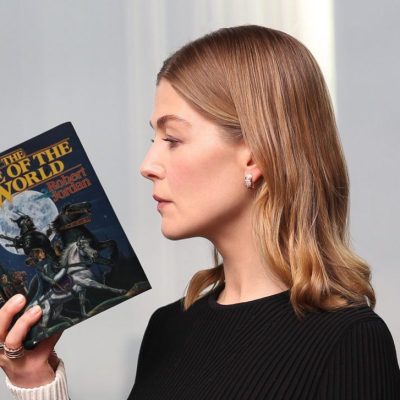How The Wheel of Time Adapts a Sprawling Epic Fantasy
The Wheel of Time showrunner Rafe Judkins shares how his elaborate high fantasy adaptation will enchant fans old and new.

Robert Jordan’s The Wheel of Time series would seem to defy adaptation with its massive cast of characters, centuries of history, and sprawling world map. The danger of alienating longtime fans of the books with inaccuracies or confusing newcomers with too many details is very real. However, showrunner Rafe Judkins was up to the challenge, deciding which aspects of the novels made the story original and bringing those key aspects to television. “I think it’s our job to both be true to the Wheel of Time books but also be mindful of… the things that could feel repetitive [and those] that are fresh and unique,” he says.
The Wheel of Time doesn’t rely on a single protagonist, for example, but instead introduces three unwitting young heroes in a familiar fantasy journey, escaping those who would prevent them from fulfilling important destinies they know nothing about. Josha Stradowski is the reluctant Rand al’Thor; Barney Harris is the skeptical Mat Cauthon; and Marcus Rutherford is the quiet Perrin Aybara. The three friends leave small town life behind when they are unwittingly swept up in the forces of fate during the Amazon series’ first season.
“With Rand, we wanted to find an actor that really brought out not only the goodness of the character but also the complications, and really embodied this guy who was a shepherd in the mountains and never wanted this adventure that’s been thrust upon him,” says Judkins about the point-of-view character in Jordan’s debut The Wheel of Time novel.
As for the other two, Judkins says, “Mat and Perrin are so much more than sidekick characters… Sometimes people felt like they didn’t really fall in love with those characters until some of the later books when they really got to know them and got to see their POV on the world. Hopefully in the show, right from the beginning–Marcus and Barney give such strong performances–they are a part of the ensemble right up front.” However, the story’s scope quickly widens as a host of characters from across the map come to the aid of–or pursue–the boys.
For example, there’s The Wheel of Time cast headliner Rosamund Pike, who plays Moiraine Damodred, a magic channeler in an all-female order that anchors the worldbuilding of the series. “The Aes Sedai are a group of women who have access to the One Power and are able to channel,” Judkins explains. “They are not the presidents of countries or the queens of countries; they are the people who sit at the center of political power… and pull the strings of the world from the White Tower.”
The manner in which the Aes Sedai magic is depicted will need to honor its singular nature both in order to appeal to existing fans and to draw in new ones. “The channeling is so integral to the world of The Wheel of Time,” Judkins says. “The author made a system that makes sense. It works; it has rules, and you have to follow them. So we’ve been really careful on the show to make sure that we’re holding to all of those same rules.”
Using magic in The Wheel of Time, however, is not simply a matter of chanting, hand-waving, and adding pyrotechnics in post-production. “We didn’t just send it off to VFX and say, ‘Give us a simple light show.’ We started with Rosamund and a movement coach,” says Judkins. “Threads [of magic] are woven together; they call them weaves; they call it channeling. We went through everything in the books and passages discussing what it feels like to embrace the Source, what it feels like to weave things together.”
Other details, such as the disparate journeys of the characters in The Wheel of Time, must necessarily be compressed, with certain major characters absorbing roles of minor characters throughout the series. “We’ll never be able to achieve everything that’s in the books,” Judkins admits. “What are the iconic places that we need to do, and do we need to shift things around in physical space in order to hit them? … I don’t want to waste all my production money putting town after town on screen.”
That being said, the world of The Wheel of Time has a wealth of different cultures with their own unique customs that it would be a shame not to honor. “[Jordan] really built this huge geo-political world, and the cultures of the different nations were so distinct,” says Judkins. “In the first book, they don’t go to as many of those places, but the ones we do–the detail to which they are thought through in trying to deliver exactly the culture that was represented in the books in those places is extremely thorough.”
Judkins’ faith in the worldbuilding of the source material eliminates any worry about the inevitable comparisons to Game of Thrones. “The Wheel of Time came out before Game of Thrones, in terms of the books. There’s so much that is in Game of Thrones – and George [R.R. Martin] will say this – that was inspired by The Wheel of Time,” he says. “But we as creators have to be mindful of the fact that Game of Thrones has already come out and is a reference point for a lot of audiences.”
That accessibility is going to be a key factor in bringing in viewers unfamiliar with The Wheel of Time books, but with all of the careful attention to only the most important details, Judkins and his team appear to be up to the challenge. As characters often say in the Jordan novels, “The Wheel weaves as the Wheel wills,” and only a fickle audience can decide whether the Amazon adaptation succeeds when it arrives this fall.
The Wheel of Time premieres on Amazon Prime in November.


